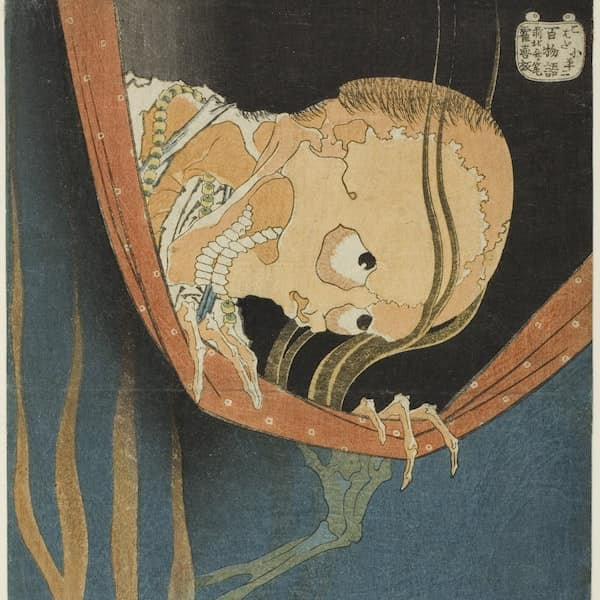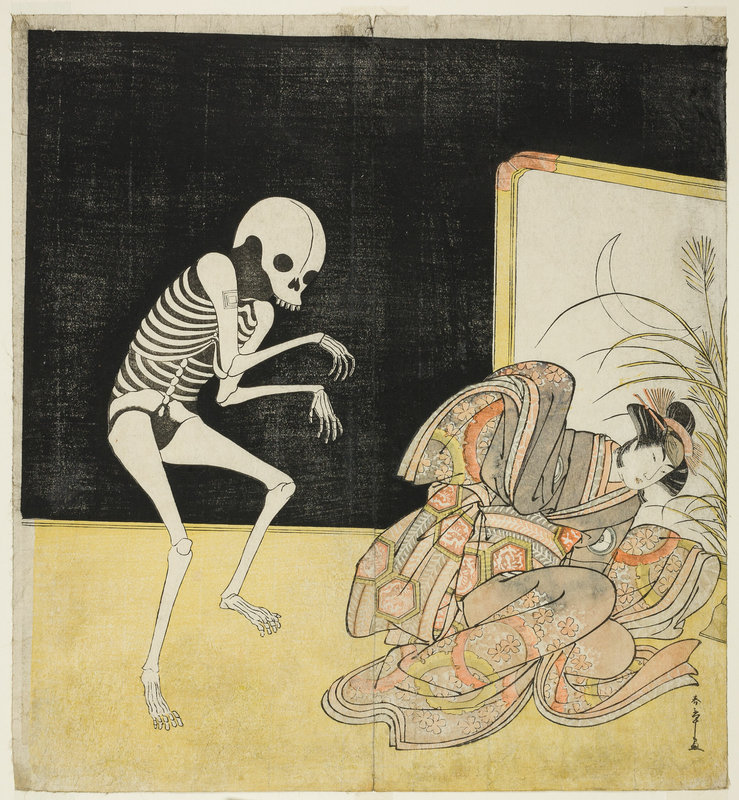'Ghosts and Demons in Japanese Prints' at The Art Institute Chicago

Katsushika Hokusai (Japanese, 1760-1849), Kohada Koheiji, from the series “One Hundred Ghost Tales (Hyaku monogatari)”, c. 1831. Color woodblock print; chuban, 25.6 × 18.1 cm. Clarence Buckingham Collection, 1943.602. Courtesy Art Institute Chicago
CHICAGO - There’s a Chinese legend about a man, Zhong Kui, who failed the examinations to become a scholar-official and subsequently took his life. The emperor, upon hearing of this tragedy, had Zhong Kui buried with high honors, therefore securing his protection after death as a spirit guardian who would protect the country from supernatural forces.

Okumura Masanobu (Japanese, 1686-1764), Shoki, the Demon Queller, c. 1745. Hand-colored woodblock print; habahiro hashira-e, urushi-e; 58.9 × 25.7 cm. Clarence Buckingham Collection, 1942.123. Courtesy Art Institute Chicago
In Japan, Zhong Kui was called Shōki the Demon Queller and depicted in prints as a Chinese official dressed in a dark robe, boots, and cap, wielding the sword he uses to subdue demons. A popular subject, his image was often displayed in homes and on banners in the belief that it helped to ward off disease.

Kawanabe Kyōsai (Japanese, 1831-1889), May: Shoki the Demon Queller Riding on a Tiger, Subjugating Goblins, from the series “Of the Twelve Months: the Fifth (Junikagetsu no uchi: gogatsu)”, 1887. Color woodblock prints; oban triptych; 35.7 × 73.2 cm. Nathalie Gookin Fund in memory of Frederick Gookin, 1984.1371. Courtesy Art Institute Chicago
Supernatural beings have always been common features in Japanese legends, prints, and Kabuki theater. The prints on view in this exhibition, all from our celebrated Clarence Buckingham collection, capture common Japanese folk tales as well as their Kabuki adaptations from the early 18th-century to the last years of the 19th century, offering distinct insight into the nature of these beloved stories and characters.

Katsukawa Shunshō (Japanese, 1726-1792), The actors Ichikawa Danjuro V as a skeleton, spirit of the renegade monk Seigen (left), and Iwai Hanshiro IV as Princess Sakura (right), in the joruri "Sono Omokage Matsu ni Sakura (Vestiges of Pine and Cherry)," from part two of the play "Edo no Hana Mimasu Soga (Flower of Edo: An Ichikawa Soga)," performed at the Nakamura Theater from the first day of the second month, 1783. Color woodblock print; hosoban diptych; Right: 32.9 × 15 cm, Left: 32.9 × 15.2 cm. Clarence Buckingham Collection, 1938.491. Courtesy Art Institute Chicago
Amid the performances depicted in these prints are Kaidan mono, or Kabuki ghost plays. Ghost plays were known to feature dramatic special effects: quick costume changes in moments when an actor transformed into a ghost or the use of trap doors and flying apparatuses to terrify and excite the audience. Kaidan mono were most often put on in the heat of summer, the traditional time for telling ghost stories. Tales were meant to give the audience a chill. It’s our hope that this summer exhibition of these astonishing prints brings visitors a chill of their own.

Katsushika Hokusai (Japanese, 1760-1849), Kohada Koheiji, from the series “One Hundred Ghost Tales (Hyaku monogatari)”, c. 1831. Color woodblock print; chuban, 25.6 × 18.1 cm. Clarence Buckingham Collection, 1943.602. Courtesy Art Institute Chicago
Ghosts and Demons in Japanese Prints is curated by Janice Katz, Roger L. Weston Associate Curator of Japanese Art, the Art Institute of Chicago. Jul 15–Oct 15, 2023

/https%3A%2F%2Fprofilepics.canalblog.com%2Fprofilepics%2F1%2F0%2F100183.jpg)
/https%3A%2F%2Fstorage.canalblog.com%2F03%2F02%2F119589%2F96711876_o.jpg)
/https%3A%2F%2Fstorage.canalblog.com%2F11%2F31%2F119589%2F94773502_o.jpg)
/https%3A%2F%2Fstorage.canalblog.com%2F20%2F83%2F119589%2F94772815_o.jpg)
/https%3A%2F%2Fstorage.canalblog.com%2F26%2F72%2F119589%2F75604929_o.jpg)
/https%3A%2F%2Fstorage.canalblog.com%2F59%2F60%2F119589%2F26458628_o.jpg)


/http%3A%2F%2Fstorage.canalblog.com%2F78%2F04%2F119589%2F129645581_o.jpg)
/http%3A%2F%2Fstorage.canalblog.com%2F35%2F12%2F119589%2F128691391_o.jpg)
/http%3A%2F%2Fstorage.canalblog.com%2F76%2F58%2F119589%2F127243024_o.jpg)
/http%3A%2F%2Fstorage.canalblog.com%2F62%2F06%2F119589%2F126965597_o.jpg)